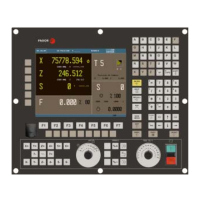·314·
Installation manual
CNC 8055
CNC 8055i
7.
CONCEPTS
SOFT: V02.2X
Movement with an electronic handwheel
Configuring the additive handwheel
When enabling the additive handwheel, the following must be borne in mind.
• If the DWELL parameter of an axis has been set and it is not previously in motion, it activates
the ENABLE mark of the axis and waits a time period indicated in DWELL to check whether its
SERVOON has been activated or not.
• The acceleration applied to the additive handwheel movement is that of parameter. ACCTIME
of the axis.
• On Gantry axes, slaved or synchronized by PLC, the movement of the master axis using an
additive handwheel is also applied to the slave axis.
• The mirror image by PLC is not applied to the additive handwheel movement.
• When testing the software limits during block preparation, it checks the theoretical coordinate
ignoring the additional movement of the additive handwheel.
The additive handwheel is configured by machine parameters and is activated and deactivated by
PLC.
Activating and deactivating the additive handwheel
The additive handwheel is activated and deactivated with the mark MANINT(X-C). The PLC sets
one of these signals high to activate the additive handwheel on each axis. Only one additive
handwheel may be enabled at a time. If there are more than one mark active, only the first one will
be attended to.
Configuring the additive handwheel
The parameter ADIMPG enables the additive handwheel and makes it possible to configure its
operation.
Handwheel resolution and maximum feedrate
The resolution of the additive handwheel depends on the setting of parameter ADIMPG (P176).
There are two options to set the resolution:
• The resolution of the handwheel is set by parameter ADIMPRES (P177) of the axis.
• The handwheel resolution is set with the switch of the operator panel. If the switch is not in the
handwheel position, it assumes a x1 factor.
Maximum feedrate allowed, due to the additive handwheel, is limited by parameter ADIFEED (P84).
Coordinates display
Parameter DIPLCOF determines whether the CNC takes into consideration or not the additive zero
offset when displaying the coordinates of the axes on the screen and when accessing the POS(X-
C) and TPOS(X-C) variables.

